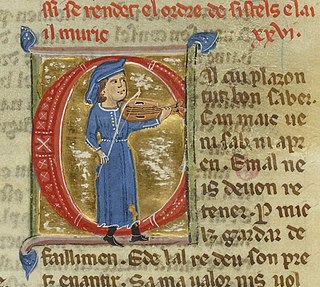
A troubadour was a composer and performer of Old Occitan lyric poetry during the High Middle Ages (1100–1350). Since the word troubadour is etymologically masculine, a female troubadour is usually called a trobairitz.
Occitan literature is a body of texts written in Occitan, mostly in the south of France. It was the first literature in a Romance language and inspired the rise of vernacular literature throughout medieval Europe. Occitan literature's Golden Age was in the 12th century, when a rich and complex body of lyrical poetry was produced by troubadours writing in Old Occitan, which still survives to this day. Although Catalan is considered by some a variety of Occitan, this article will not deal with Catalan literature, which started diverging from its Southern French counterpart in the late 13th century.

Peire Cardenal was a troubadour known for his satirical sirventes and his dislike of the clergy. Ninety-six pieces of his remain, a number rarely matched by other poets of the age.
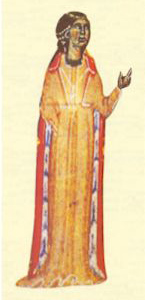
The trobairitz were Occitan female troubadours of the 12th and 13th centuries, active from around 1170 to approximately 1260. Trobairitz is both singular and plural.

Raimon Jordan was a Toulousain troubadour and the viscount of Saint-Antonin in the Rouergue near the boundary with Quercy.

The (Lo) Monge de Montaudon, born Pèire de Vic, was a nobleman, monk, and troubadour from the Auvergne, born at the castle of Vic-sur-Cère near Aurillac, where he became a Benedictine monk around 1180. According to his vida, he composed "couplets while he was in the monastery and sirventes on subjects that were popular in the region."
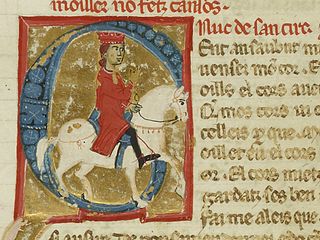
Uc de Saint Circ or Hugues (Hugh) de Saint Circq was a troubadour from Quercy. Uc is perhaps most significant to modern historians as the probable author of several vidas and razos of other troubadours, though only one of Bernart de Ventadorn exists under his name. Forty-four of his songs, including fifteen cansos and only three canso melodies, have survived, along with a didactic manual entitled Ensenhamen d'onor. According to William E. Burgwinkle, as "poet, biographer, literary historian, and mythographer, Uc must be accorded his rightful place as the 'inventor' (trobador) of 'troubadour poetry' and the idealogical trappings with which it came to be associated."
Bernat or Bernart d'Auriac was a minor troubadour notable mainly for initiating a cycle of five short sirventes in the summer of 1285. According to a rubric of the chansonnier in which the cycle is preserved, Bernart was a mayestre de Bezers.
Bertran Carbonel was a Provençal troubadour from Marseille. He is a polarising figure among scholars and his reputation varies between authorities. Eighteen of his lyric works survive, as well as seventy-two or ninety-four (Riquer) single coblas triadas esparsas on "edifying" themes. He was patronised at the court of Hugh IV and Henry II of Rodez.
Guilhem Peire Cazals de Caortz or Guilhem Peire de Cazals was a troubadour of the first half of the thirteenth century. He was born or lived in Cahors, Quercy, from which his name "de Caortz". Eleven of his works, including one tenso, survive.

Gui de Cavalhon, Cavaillo, or Gavaillo was a Provençal nobleman: a diplomat, warrior, and man of letters. He was probably also the Guionet who composed tensos and partimens with Cadenet, Raimbaut de Vaqueiras, Mainart Ros, Pomairol, and a certain Guillem.

Guilhem Ademar was a troubadour from the Gévaudan in France. He travelled between the courts of Albi, Toulouse, Narbonne, and Spain. He achieved fame enough during his life to be satirised by the nobleman and monk, Monge de Montaudon. Guilhem entered holy orders towards the end of his life. Sixteen poems—fourteen cansos, a sirventes, and a partimen with Eble d'Ussel—form his surviving corpus. His cansos are his most famous pieces. Usually humorous, several mock the poetry of Ademar's more illustrious contemporary Arnaut Daniel. One canso survives with a tune.
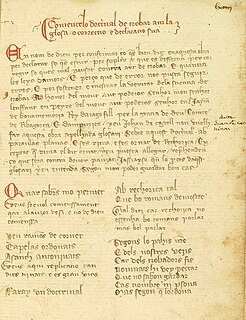
Raimon de Cornet was a fourteenth-century Toulousain priest, friar, grammarian, poet, and troubadour. He was a prolific author of verse; more than forty of his poems survive, most in Occitan but two in Latin. He also wrote letters, a didactic poem, a grammar, and some treatises on computation. He was the "last of the troubadours" and represented l'esprit le plus brillant of the "Toulousain School". He appears in contemporary documents with the titles En and Frare.

Joan de Castellnou was a troubadour of the Consistori del Gay Saber active in Toulouse. He left behind five or six cansos, three vers, a dansa, a conselh, and a sirventes. His most famous works are non-lyric, however: a grammar (compendi) called Las flors del gay saber, estier dichas las Leys d'amors and a glossary (glosari) on the Doctrinal (1324) of his predecessor, Raimon de Cornet.
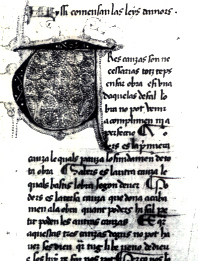
The Consistori del Gay Saber was a poetic academy founded at Toulouse in 1323 to revive and perpetuate the lyric poetry of the troubadours.
The Cançoneret de Ripoll, now manuscript 129 of Ripoll in the Arxiu de la Corona d'Aragó, is a short Catalan-Occitan chansonnier produced in the mid-fourteenth century but after 1346, when Peter IV of Aragon held a poetry competition which is mentioned in the chansonnier. Influenced by Cerverí de Girona, the chansonnier and its ideology serve as transition in the history of Catalan literature between the dominance of the troubadours and the new developments of Ausiàs March.
There were three troubadours named Isarn or Izarn, and who are difficult to distinguish completely today. The first has no surname and composed two partimens with Rofian around 1240. He has been confounded with the inquisitor Isarn.

A maldit was a genre of Catalan and Occitan literature practised by the later troubadours. It was a song complaining about a lady's behaviour and character. A related genre, the comiat, was a song renouncing a lover. The maldit and the comiat were often connected as a maldit-comiat and they could be used to attack and renounce a figure other than a lady or a lover, like a commanding officer. The maldit-comiat is especially associated with the Catalan troubadours. Martí de Riquer describes un autèntic maldit-comiat as a song where a poet leaves a mistress to whom he has long been fruitlessly devoted, and explains her failings which have led him to depart.
Nationality words link to articles with information on the nation's poetry or literature.











